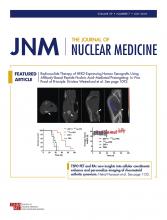Prostate-specific membrane antigen (PSMA) is highly expressed in prostate epithelial cells and strongly upregulated in prostate cancer. Therefore, PSMA is an appropriate target for the diagnosis and therapy of prostate cancer and its metastases. Since 2013, an increasing number of centers worldwide have begun using radioligand therapy (RLT) with 177Lu-PSMA (1–4). Several studies have demonstrated the safety and low toxicity profile of 177Lu-PSMA for the therapy of patients with metastatic castration-resistant prostate cancer (1,3,5–8). Up to 80% of these patients will respond to treatment with 177Lu-PSMA as measured by any decline in prostate-specific antigen (PSA) (1,5,6,8–13). Studies involving 177Lu-PSMA-617 and 177Lu-PSMA-I&T have observed a reduction in PSA levels of 50% or more in 32%–60% of patients.
Various pretherapeutic parameters have been evaluated to determine whether there are predictors of response to RLT. Ferdinandus et al. (10) evaluated the prognostic value of some pretherapeutic parameters on therapy response based on changes in PSA after the first cycle of RLT. Their multivariate analysis of these parameters, in which any decrease in PSA after 2 mo was considered to represent a response, showed that patients with a high platelet count or a regular need for analgesics had a significantly lower response rate to the first cycle of RLT. According to Ferdinandus et al., the SUVmax of 68Ga-PSMA-11 was not a significant predictor of the response to 177Lu-PSMA RLT. One explanation could be that although more aggressive tumors may express higher PSMA uptake, this uptake level does not correlate with the response rate because of the rapid progression of the disease. Other explanations could be differences in the residency time of radioactivity in the metastases and differences in the compounds used for imaging and treatment.
It seems that prior therapies have no significant impact on response rate. According to the multicenter German Study, relevant independent predictors of biochemical response included an alkaline phosphatase level of less than 220 U/L, the absence of visceral metastases, and a higher number of therapy cycles (3). About 88%–93% of patients with a PSA response after the first cycle responded to further cycles (6,9,12), whereas approximately 40% of nonresponders responded to further therapy cycles (9,12). Response to RLT based on PSA changes is actually one of the most significant parameters of overall survival, according to multiple studies showing that the median overall duration of survival was significantly longer for patients who exhibited a PSA decline 2 mo after the first cycle than for patients without a PSA decline (median, 63–71 wk vs. 33–47 wk, respectively) (9,13,14). According to various guidelines and trials, response to a therapy is defined as a decline in PSA level by at least 50%; however, in patients being treated with 177Lu-PSMA as a last option, the disease is typically in a very aggressive phase with a rapidly rising PSA level before RLT. Thus, a PSA level that is unchanged 2 mo after the first cycle of RLT could be considered a response to treatment. In one of our recently published studies (13), we reported the predictive factors of overall survival in 104 patients who had received all the approved therapies. In that study, in addition to a PSA decline after the first cycle, an alkaline phosphatase level with a cutoff of 220 U/L and a cumulative administered activity with a cutoff of 18.8 GBq were further significant prognostic factors of overall survival.
Thus far, a standard administered activity of 177Lu-PSMA has not been determined by prospective trials. A wide range of activities—up to 9.3 GBq—has been used in safety and toxicity trials reported in the literature, and it seems that there is no correlation between initial PSA response and the amount of therapeutic activity (3,15). The fact that some studies have found a negative correlation between the amount of tumor involvement and the dose absorbed by nontarget organs encourages us to increase the activity for at least the first cycle in patients with high tumor involvement (16,17). This issue should continue to be investigated and proved in prospective studies. It is still unclear why about 20% of patients do not respond to 177Lu-PSMA therapy; however, there is no treatment option with a 100% response rate. One reason could be that these patients have more aggressive types of prostate cancer with neuroendocrine differentiation or with somatic genomic alterations or specific germline mutations, such as BRCA2 (18).
The specific amount of 177Lu-PSMA activity may also be an important issue in determining therapy response. 177Lu-PSMA therapy is not curative; therefore, the combination of RLT with other synergistic therapies, such as immunotherapy, may increase its efficacy (19). At the moment, according to the published retrospective studies, the following criteria may be the most suitable for patient selection: histologically proven prostate carcinoma; nonresectable metastases; tumor progression under treatment according to current guidelines; PSMA expression by the metastases, detected by PSMA imaging; sufficient hematologic function (leukocyte count > 2.0 × 109/L, thrombocyte count > 75 × 109/L); normal or slightly decreased renal function (creatinine level < 2 times the upper standard limit) without any evidence of obstructive renal disease, evaluated by 99mTc-mercaptoacetyltriglycine or 99mTc-diethylenetriaminepentaacetic acid; sufficient liver function (aspartate aminotransferase or alanine aminotransferase < 5 times the upper standard limit); a 6-wk interval after myelosuppressive therapy; and an Eastern Cooperative Oncology Group performance status of 2 or less.
All of above-mentioned data are based on retrospective analysis and therefore should be regarded accordingly and used carefully. A prospective phase 3 study that is being planned by Endocyte (VISION trial) will hopefully augment our knowledge of this therapy.
DISCLOSURE
No potential conflict of interest relevant to this article was reported.
Footnotes
Published online Apr. 13, 2018.
- © 2018 by the Society of Nuclear Medicine and Molecular Imaging.
REFERENCES
- Received for publication March 9, 2018.
- Accepted for publication April 9, 2018.







